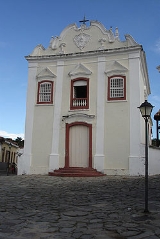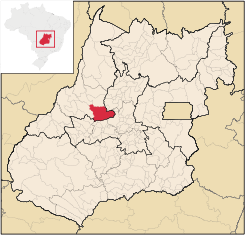
Goiás, Goiás
Encyclopedia
| Goiás | |
|---|---|
| State | Goiás Goiás Goiás is a state of Brazil, located in the central part of the country. The name Goiás comes from the name of an indigenous community... |
| Area: | 3,108.0 km² |
| Population: | 24,472 (IBGE 2007) |
| Elevation: | 496 m above sea level |
| Postcode (CEP): | 76600-000 |
| Became a city: | 1727 |
| Distance to Goiânia Goiânia -Climate:The city has a tropical wet and dry climate with an average temperature of . There's a wet season, from October to April, and a dry one, from May to September. Annual rainfall is around 1,520 mm.... : |
148 km |
| IBGE statistical microregion: | Rio Vermelho Microregion Rio Vermelho Microregion The Rio Vermelho Microregion is a geographical region in central Goiás state, Brazil. The most important city is Goiás, also known as Goiás Velho. The Rio Vermelho, a tributary of the Araguaia River flows through the region... |
| Website: | Prefeitura Municipal da cidade de Goiás |
| Coordinates: | 15°55′20"S 50°08′16"W |

City
A city is a relatively large and permanent settlement. Although there is no agreement on how a city is distinguished from a town within general English language meanings, many cities have a particular administrative, legal, or historical status based on local law.For example, in the U.S...
and municipality
Municipality
A municipality is essentially an urban administrative division having corporate status and usually powers of self-government. It can also be used to mean the governing body of a municipality. A municipality is a general-purpose administrative subdivision, as opposed to a special-purpose district...
in the state of Goiás
Goiás
Goiás is a state of Brazil, located in the central part of the country. The name Goiás comes from the name of an indigenous community...
in Brazil
Brazil
Brazil , officially the Federative Republic of Brazil , is the largest country in South America. It is the world's fifth largest country, both by geographical area and by population with over 192 million people...
. The population was 24,072 (2007 count) in a total area of 3,108 km² (2002). It is the former capital of the state and preserves much of its colonial heritage. In 2002, it became a UNESCO
UNESCO
The United Nations Educational, Scientific and Cultural Organization is a specialized agency of the United Nations...
World Heritage Site
World Heritage Site
A UNESCO World Heritage Site is a place that is listed by the UNESCO as of special cultural or physical significance...
.
World Heritage Site
It was the old state capital of GoiásGoiás
Goiás is a state of Brazil, located in the central part of the country. The name Goiás comes from the name of an indigenous community...
until 1937, when the government seat was transferred to the recently built Goiânia
Goiânia
-Climate:The city has a tropical wet and dry climate with an average temperature of . There's a wet season, from October to April, and a dry one, from May to September. Annual rainfall is around 1,520 mm....
. It was founded by the famed Bandeirante explorer Bartolomeu Bueno da Silva, nicknamed the Anhangüera, and was called in colonial times Vila Boa de Goyaz ("good village of Goias" in archaic Portuguese). Given its historical importance, the historical center of Goiás was included on UNESCO
UNESCO
The United Nations Educational, Scientific and Cultural Organization is a specialized agency of the United Nations...
's World Heritage list in 2001.
Location
Municipal boundaries:- North: Faina
- South: MossâmedesMossâmedesMossâmedes is a small town and municipality in western Goiás state, Brazil.-Location:Mossâmedes is located northwest of the state capital, Goiânia in the Anicuns Microregion. It is connected by paved roads with Itaberaí to the north and Anicuns to the south. The distance to the state capital is...
- East: ItaberaíItaberaíItaberaí is a small city and municipality in central Goiás state, Brazil. Itaberaí is a large producer of agricultural products including corn, rice, soybeans, tomatoes, and sugarcane.-Location:...
- West: ItapirapuãItapirapuãItapirapuã is a small town and municipality in the state of Goiás in Brazil. The population was 8,208 in 2007 in a total area of 2,043.7 km² . Itapirapuã is a large producer of cattle.-Location and Boundaries:...
and MatrinchãMatrinchãMatrinchã is a small town and municipality in west-central Goiás state, Brazil.-Location:*Statistical microregion: Rio Vermelho Microregion*Distance to the state capital: 261 km.*Distance to regional center : 106 km....
- Districts: Calcilândia, Buenolândia, Davidópolis, São João e Uvá. *Povoado (village): São João da Lajinha.
- Aglomerados (smaller than a village): Areias and Ferreiro
Distances
- Goiânia : 148 km
- Aruanã : 178 km
- Brasília : 307 km
Access can be made by highways GO-070 / Goianira
Goianira
Goianira is a small city and municipality in central Goiás state, Brazil, located 32 kilometers northwest of the state capital, Goiânia. The population was 24,110 in a total area of 200.4 km² . Goianira is becoming a major producer of shoes.Goianira is four kilometers east of highway BR-457 /...
/ Inhumas
Inhumas
Inhumas is a small city and municipality in central Goiás state, Brazil. The population was 47,361 in a total area of 613.3 km²...
/ Itaberaí
Itaberaí
Itaberaí is a small city and municipality in central Goiás state, Brazil. Itaberaí is a large producer of agricultural products including corn, rice, soybeans, tomatoes, and sugarcane.-Location:...
/ BR-070.Sepin
Geography
The topography of the municipality is characterized by rugged terrain and several rivers. The Serra Dourada Mountains are nearby. Waterfalls and rapids are easily accessible from the center and several of them have beaches open to the public. The most important are:- Balneário Cachoeira Grande, 6 km from the city
- Balneário Santo Antônio, 6 km from the city
- Balneário Bacalhau, at the entrance to the city
Rivers that cross the municipality are:
- Rio Vermelho, Urú, do Peixe, Ferreira and Índio
Political data
- Eligible voters: 20,670 (12/2007)
- Mayor: Márcio Ramos Caiado (January 2009)
- Vice-mayor: Joaquim Berquó Neto
- Councilmembers: 09
Demographic data
- Population growth rate 2000/2007: -1.46%
- Population in 1980: 42,967
- Population in 1991: 27,782
- Urban population in 2007: 17,54
- Rural population in 2007: 6,932
Economy
The economy of the region is dependent on tourism, cattle raising, and agriculture. The cattle herd consisted of 241,000 head.The main agricultural products were banana, oranges, hearts of palm, rice (2,600 hectares), beans, corn (3,800 hectares), soybeans and wheat
Economic data
- Banking institutions: BRADESCO S.A. - Banco do Brasil S.A. - Banco Itaú S.A. - CEF. (08/2007)
- Meat-packing houses: Frigorífico Margem Ltda
Education and health
- Literacy rate: 85.4%
- Infant mortality rate: 28.53 in 1,000 live births
- Schools: 52 (2006) with 7,913 students
- Higher education: UEG - Faculdade de Filosofia Cora Coralina - FFCC. - UFG - Campus Avançado.
- Hospitals: 03 (2007)
- Hospital beds: 190
- Walk-in public health clinics: 16
History
Goiás Velho was founded in 1727, its name being a tribute to the Goyaz Indians, the inhabitants of the area before the arrival of the Europeans. Its houses, chapels and churches are testimony to the height of the gold rush era. The history of the town, which is intertwined with the history of Goiás state, and certain reminders of the wealth of past centuries carved in gold, can be seen in places such as the Museu das Bandeiras, built in 1761; the Colégio Sant'Ana, founded in 1879 by Dominican friars; the church of Nossa Senhora d'Abadia, constructed in 1790, with its altar painted in blue and gold; and the Casa da Fundição, dating from 1752, where the gold from the mines was cast.Surrounded by the Serra Dourada, Goiás Velho is the native city of the poet Ana Lins dos Guimarães Peixoto Bretas (1889-1985), better known as Cora Coralina
Cora Coralina
Cora Coralina was a Brazilian writer and poetess. She was born August 20, 1889, and died in the city of Goiânia on April 10, 1985. She published her first book after her husband died in 1965...
. Although she started writing at 14 years of age, she published her first book when she was 75. In order to survive, she made and sold crystallised sweets. The house where she lived, one of the oldest in the city, dating from 1782, has become a museum, containing her furniture, personal possessions, documents and letters from illustrious correspondents such as the poet Carlos Drummond de Andrade
Carlos Drummond de Andrade
Carlos Drummond de Andrade was perhaps the most influential Brazilian poet of the 20th century. He has become something of a national poet; his poem "Canção Amiga" was printed on the 50 cruzados note...
(1902-1987) and the Bahian writer Jorge Amado
Jorge Amado
Jorge Leal Amado de Faria was a Brazilian writer of the Modernist school. He was the best-known of modern Brazilian writers, his work having been translated into some 49 languages and popularized in film, notably Dona Flor and her Two Husbands in 1978...
, one of the main representatives of the literature of the North East region and one of the most widely read Brazilian authors both inside and outside the country.
Festivals
In Goiás, the most popular festival is the Procession of the Fogaréu, which occurs on the Wednesday before Easter Sunday. It is one of the most traditional events of Holy Week in Brazil and only in Angra dos ReisAngra dos Reis
Angra dos Reis is a Brazilian municipality located in the southern part of Rio de Janeiro state. It is located at an altitude of 6 meters and includes in its territory 365 offshore islands. It was discovered on January 6, 1502, but has been under continual settlement since 1556. Its population...
is a similar procession celebrated. During the ceremony the farricocos
Cuco
The Coco is a mythical ghost-monster; equivalent to the boogeyman, found in many Hispanic and Lusophone countries. He can also be considered a Hispanic version of a bugbear, as it is a commonly used figure of speech representing an irrational or exaggerated fear...
(the people dressed in medieval robes and hoods that accompany processions of penitence) simulate the arresting of Jesus by running through the streets of the town at midnight with torches to the sound of drums. There is a great resemblance with some traditions that take place in Spain at the same time of year especially in Toledo
Toledo, Spain
Toledo's Alcázar became renowned in the 19th and 20th centuries as a military academy. At the outbreak of the Spanish Civil War in 1936 its garrison was famously besieged by Republican forces.-Economy:...
and Sevilla. The darkness, the torches, and the speed of the men with covered faces create a medieval atmosphere, frightening and exciting.
It was believed that the devil was loose in the streets of the town on that night, frightening all, especially the children. Originally, only men could participate but today that has changed. Superstitions like the presence of a werewolf and a headless mule are also manifested in this popular festival.
Tourists come from far and wide to witness the spectacle. In 2006, according to the Diario da Manhã a newspaper from Goiânia
Goiânia
-Climate:The city has a tropical wet and dry climate with an average temperature of . There's a wet season, from October to April, and a dry one, from May to September. Annual rainfall is around 1,520 mm....
, 10,000 tourists came to watch the procession.
For photos see http://www.dm.com.br/galeria/index.php?id=194 and http://www.vilaboadegoias.com.br/fogareu.htm
Municipal Human Development IndexHuman Development IndexThe Human Development Index is a composite statistic used to rank countries by level of "human development" and separate "very high human development", "high human development", "medium human development", and "low human development" countries...
- MHDI: 0.736
- State ranking: 125 (out of 242 municipalities in 2000)
- National ranking: 2,283 (out of 5,507 municipalities in 2000)

